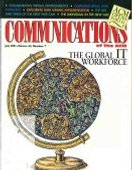July 2001 - Vol. 44 No. 7

Features
Legally Speaking: The Individual in the New Age
The Business of Software: Matching Process to Types of Teams
On Site: The Life and Times of the First Web Cam
Viewpoint: Developing IT Skills Internationally: Who’s Developing Whom?
The Global IT Work Force: Introduction
Growth Scenario of IT Industries in India
The Decline and Fall of the American Programmer
Some Thoughts on IT Employment in New Zealand
A Perspective on the IT Industry in South Africa
Crafting an HR Strategy to Meet the Need For IT Workers
Labor Shortfall in Hong Kong’s IT Industry
Facilitating Career Changes Into IT
Mapping Information-Sector Work to the Work Force
The IT Staffing Situation in Belarus
Collaborative Virtual Environments
Exploring Data Mining Implementation
Intraorganizational Communication with Intranets
Inside Risks: Learning from Experience



